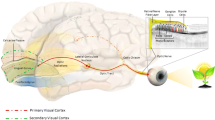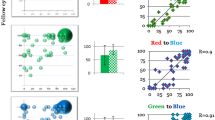Abstract
Objective
To assess the type and degree of both red–green and blue–yellow color vision deficiencies of Calabrian males affected by multiple sclerosis.
Material
Eighty Calabrian male patients were enrolled (age range 18–70 years; mean age 40.6 ± 12.4 years) showing a disease duration mean of 10.6 ± 8.2 years (range = 0.5–46 years) coming from the Institute of Neurology, Magna Graecia University, Catanzaro. Optic neuritis present in the medical histories of the 21 patients does not influence color vision. Excluding seven colorblind subjects and one affected by a bilateral maculopathy, the analyzed sample group was 72. Seventy controls were matched for age and sex.
Method
An ophthalmologist examined all patients and controls in order to rule out diabetic retinopathy, cataracts, senile maculopathy, or ocular fundus’ anomalies. The Ishihara test identified the colorblind patients. The City University Test screened for people with abnormal color vision by grading the severity of color vision deficiency. The second part of the City University Test as well as the Farnsworth Test confirmed both the color vision deficiency type and degree.
Results
Fifty-one percentage (37/72) of the patients showing a color vision deficiency were subdivided into two subgroups: subgroup one showed red–green deficiency (57%, 21/37); subgroup two showed a coupled red–green and blue–yellow deficiency (43%, 16/37). Furthermore, we found two distinct curves showing a groove within the first 10 years of the disease. Both monocular and binocular analyses allowed us to identify the patients showing the monocular color vision deficiency, but they were well compensated by binocular vision.
Conclusion
We think that the majority of the patients with the red–green deficiency will develop the coupled red–green and blue–yellow deficiency in the latter years of multiple sclerosis.
Similar content being viewed by others
References
Zeki S (1993) A vision of the brain. Blackwell Scientific Publication, Oxford
Birch J (2001) Diagnosis of defective colour vision. Butterworth-Heinemann, Oxford
Fletcher R, Voke J (1885) Defective color vision. Fundamentals, diagnosis and management. A. Hilger, Bristol
Piro A, Tagarelli A, Nicoletti G, Fletcher R, Quattrone A (2014) Color vision impairment in Parkinson’s disease. J Parkinson Dis 4:317–319
Cole BL, Lian KY, Lakkis C (2006) The new Richmond HRR pseudoisochromatic test for colour vision is better than the Ishihara test. Clin Exp Optom 89:73–80
Lampert EJ, Andorra M, Torres-Torres R, Ortiz-Pèrez S, Llufriu S, Sepulveda S, Sola N, Saiz A, Sanchez-Dalmau B, Villoslada P, Martinez-Lapiscina Elena H (2015) Color vision impairment in Multiple Sclerosis points to retinal ganglion cell damage. J Neurol 262:2491–2497
Lyon MF (1961) Gene action in the X-chromosome of the mouse (Mus musculus L.). Nature 190:372–373
Tagarelli A, Piro A, Tagarelli G, Zinno F (2000) Color-blindness in Calabria (Southern Italy): a north–south decreasing trend. Am J Hum Biol 12:17–24
Kurtzke JF, Beebe GW, Norman JE (1979) Epidemiology of Multiple Sclerosis in U.S. veterans: 1. Race, sex, and geographic distribution. Neurology 29:1228–1235
Pugliatti M, Rosati G, Carton H, Riise T, Drulovic J, Vécsei L, Milanov I (2006) The epidemiology of Multiple Sclerosis in Europe. Eur J Neurol 13:700–722
Dunn SE, Lee H, Pavri FR, Zhang MA (2015) Sex-based differences in Multiple Sclerosis (part I): biology of disease incidence. Curr Top Behav Neurosci 26:29–56
Ramien C, Taenzer A, Lupu A, Heckmann N, Engler JB, Patas K, Friese MA, Gold SM (2016) Sex effects on inflammatory and neurodegenerative processes in Multiple Sclerosis. Neurosci Biobehav Rev 67:137–146
Ishihara S (1982) The series of plates designed as a test of colour-blindness, 38 Plates edn. Kanehara S. Co., Ltd., Tokyo
Long GM, Lyman BJ, Tuck JP (1985) Distance, duration and blur effects on the perception of pseudoisochromatic stimuli. Opthalmic Physiol Opt 5:185–194
Farnsworth D (1943) The Farnsworth-Munsell 100 Hue and dichotomous test for color vision. J Opt Soc Am 33:568–578
Fletcher RJ (1975) The city university color vision test, 3rd edn. Keeler Instruments, London
Kollner H (1912) Die Störungen des Farbensinners.ihre Klinische bedeutung und ihre diagnose. Berlin: Karger
Walls GL (1942) How good is the H.R.R. test for color blondness? Am J Optom 36:169–193
Dreyer V (1969) Occupational possibilities of colour defectives. Acta Ophthalmol 47:523–534
Hardy LH, Rand G, Rittler MC (1954) H-R-R polychromatic plates. J Opt Soc Am 44(7):509–523
Dvorine I (1963) Quantitative classification of the colour blind. Gen Psychol 68:255–265
Sloan LL (1945) Improved screening test for red–green color deficiency composed of available P.I.C. plates. J Opt Soc Am 35:761–766
Lakowski R (1966) A critical evaluation of colour vision tests. Br J Physiol Opt 23:186–209
Umazume K, Matsuo H (1962) Tokyo Medical College test for colour vision. Die Farbe 11(1/6):45–47
Vos JJ (1972) Literature review of human macular absorption in the visible spectrum and its consequences for the cone receptor primaries. Report. Institute for Perception TNO, Soesterberg
Birch J (1997) Clinical use of the American Optical Company (Hardy, Rand and Rittler) pseudoisochromatic plates. Ophthal Physiol Opt 17:248–254
Author information
Authors and Affiliations
Corresponding author
Ethics declarations
Conflict of interest
All authors declare that they have no conflict of interest.
Ethical approval
This article contains not invasive study on patients all admitted in the Institute of Neurology, Magna Graecia University.
Informed consent
Informed consent is not needed because the patients are all admitted in the Institute of Neurology, Magna Graecia University reporting on their own medical histories.
Rights and permissions
About this article
Cite this article
Piro, A., Tagarelli, A., Nicoletti, G. et al. Impairment of acquired color vision in multiple sclerosis: an early diagnostic sign linked to the greatness of disease. Int Ophthalmol 39, 671–676 (2019). https://doi.org/10.1007/s10792-018-0838-x
Received:
Accepted:
Published:
Issue Date:
DOI: https://doi.org/10.1007/s10792-018-0838-x




